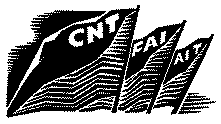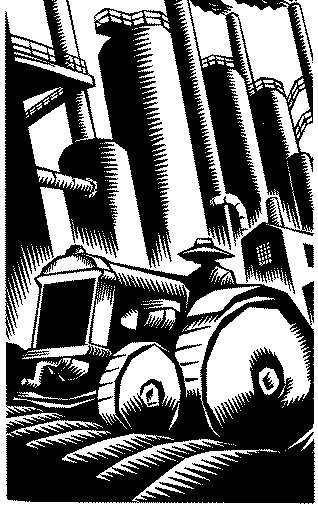




Spain's Revolutionary Anarchist Movement
(From the book "Anarchy: A Graphic Guide", written and illustrated
by Clifford Harper)
Wherever fascism's origins lay, by the mid-1930s it seemed unstoppable. In
 Spain, however, it was halted for a while by the world's strongest
anarchist movement.
The Spanish National Confederation of Labour (CNT) was formed in 1911 from
a federation of workers' and peasants' unions that had been inspired by
French anarcho-syndicalism. Completely independent, its goal was the
overthrow of capitalism and the state and the establishment of an
anarchist-communist society. This they believed could only be done by the
workers and peasants seizing the means of production in order to produce
and distribute goods and services in the interests - of the community.
Spain, however, it was halted for a while by the world's strongest
anarchist movement.
The Spanish National Confederation of Labour (CNT) was formed in 1911 from
a federation of workers' and peasants' unions that had been inspired by
French anarcho-syndicalism. Completely independent, its goal was the
overthrow of capitalism and the state and the establishment of an
anarchist-communist society. This they believed could only be done by the
workers and peasants seizing the means of production in order to produce
and distribute goods and services in the interests - of the community.
STRUCTURE
The CNT was a non-hierarchical, or horizontal, federation of many unions -
syndicatos. Each union was made up of workers grouped each in their
own particular trade. Such unions joined together in local or district
 federations which in turn were grouped into regions. The CNT itself was
formed out of
these regional federations. Regular union assemblies elected delegates to
all organisations. It was known as the 'Union of sacrifice': there
were no permanent bureaucrats or paid officials, and all union activity
was done after work
hours. The national federation was directly responsible to the regions and
so on down to the base the assemblies of workers and peasants.
federations which in turn were grouped into regions. The CNT itself was
formed out of
these regional federations. Regular union assemblies elected delegates to
all organisations. It was known as the 'Union of sacrifice': there
were no permanent bureaucrats or paid officials, and all union activity
was done after work
hours. The national federation was directly responsible to the regions and
so on down to the base the assemblies of workers and peasants.
REBELLION
By 1919, membership stood at one million. Continually outlawed, it
organised massive general strikes. Originally the CNT supported the
Russian revolution but once the nature of Bolshevik dictatorship was
revealed it cut all links with Moscow.
Declared illegal in the 1920s, the CNT fought countless gun battles with
police and fascists. Out in the open again with the downfall of the
monarchy in 1930, it prepared for revolution. The first rising, in
Catalonia in 1932, was swiftly put down. In the following year, workers
and peasants throughout Catalonia, Andalusia and Levant took up arms but
they too were defeated with incredible cruelty. 1934 saw the army
slaughter hundreds of miners in an uprising in Asturia.
REVOLUTION
July 18th, 1936. The army, led by General Franco, launched their coup
against the government. Instead of an easy victory they met immaculate,
massive resistance from the people. With the rebels supported by the
military and police, and the government in ruins, the worker and peasants
seized the administration of the country and organised a voluntary,
revolutionary militia to fight the well-armed fascists. The workers'
committees, peasants' assemblies and democratic militias were very similar
to those of the Paris Commune and Russian Revolution. The Spanish people
were not fighting to defend the government but to create a revolutionary
society.
COLLECTIVISATION
 Behind the battle lines Spanish society was transformed by a sweeping
social revolution. Seventy years of intense
struggle, anarchist education and the organisation of the CNT had prepared
the people to put into practice 'The Idea'. Collectives were created by the
free initiative of the people, not imposed by decree. Factories, mills,
mines, docks, workshops transport, public services, utilities and shops
Behind the battle lines Spanish society was transformed by a sweeping
social revolution. Seventy years of intense
struggle, anarchist education and the organisation of the CNT had prepared
the people to put into practice 'The Idea'. Collectives were created by the
free initiative of the people, not imposed by decree. Factories, mills,
mines, docks, workshops transport, public services, utilities and shops
 were re-organised and administered without bosses, managers
or state. In the countryside, yields increased by over half when three
million peasants
organised themselves in two thousand anarchist collectives. This
revolutionary transformation involved eight million men, women and
children, fighting against overwhelming odds to realise their anarchist
society.
were re-organised and administered without bosses, managers
or state. In the countryside, yields increased by over half when three
million peasants
organised themselves in two thousand anarchist collectives. This
revolutionary transformation involved eight million men, women and
children, fighting against overwhelming odds to realise their anarchist
society.
REACTION
From the outset this revolution was sabotaged. While fascist Italy and
Germany poured men and munitions into the rebel army, the 'democracies'
refused to aid the Republicans. The Republican government itself withheld
money and resources from the anarchist collectives.
Only Stalin sent arms, and then only on condition that the tiny Spanish
Communist Party be given government positions and the popular militias be
're-organised'. The communists refused arms to the CNT militias at the
front and began disarming the Barcelona workers; attacks on anarchists
were stepped up. On May 2nd, 1937, the CNT issued a warning:
'The guarantee of the revolution is the proletariat in arms. To
attempt to disarm the people is to place oneself on the wrong side of the
barricades. No councillor or police commissioner, no matter who he is, can
order the disarming of the workers, who are fighting
fascism with more self-sacrifice than all the politicians in the rear,
whose incapacity and impotence everybody knows. Do not, on any account,
allow yourselves to be disarmed!'
COUNTER REVOLUTION
Next day the Barcelona central telephone exchange, run by the CNT, was
attacked. Thousands of workers took up rifles behind their barricades.
Fighting spread, and soon the government and communist troops were
surrounded in their strongholds. The anarchist militias prepared to quit
the front for Barcelona. But instead of directing the struggle, some of
the CNT leadership now holding government posts tried to halt the fighting
and find a compromise. Meanwhile thousands of government troops converged
on the city. Confused and demoralised by their leadership's betrayal, the
workers ceased fire and laid down their arms.
DEFEAT
With Catalonian anarchism broken, the communists seized power. The
revolution was lost, though the war dragged on for two more bloody years.
The factories were forcibly returned to their owners and the collectives
put under state control. Morale at the front collapsed: troops were more
afraid of communist execution squads than of fascist bullets. Popular
hatred of the communists was such that one communist general said:
'We cannot retreat. We must stay in power at all costs, otherwise we
shall be hunted down like predatory animals in the streets.'
The end was near. The 're-organised' Republican army tried one last
offensive at Ebro, with 70,000 casualties. As tens of thousands fled into
France, General Franco's fascist army entered Barcelona on January 26th,
1939. The revolution was over.

Liberty for the People web page
 Spain, however, it was halted for a while by the world's strongest
anarchist movement.
The Spanish National Confederation of Labour (CNT) was formed in 1911 from
a federation of workers' and peasants' unions that had been inspired by
French anarcho-syndicalism. Completely independent, its goal was the
overthrow of capitalism and the state and the establishment of an
anarchist-communist society. This they believed could only be done by the
workers and peasants seizing the means of production in order to produce
and distribute goods and services in the interests - of the community.
Spain, however, it was halted for a while by the world's strongest
anarchist movement.
The Spanish National Confederation of Labour (CNT) was formed in 1911 from
a federation of workers' and peasants' unions that had been inspired by
French anarcho-syndicalism. Completely independent, its goal was the
overthrow of capitalism and the state and the establishment of an
anarchist-communist society. This they believed could only be done by the
workers and peasants seizing the means of production in order to produce
and distribute goods and services in the interests - of the community.
 federations which in turn were grouped into regions. The CNT itself was
formed out of
these regional federations. Regular union assemblies elected delegates to
all organisations. It was known as the 'Union of sacrifice': there
were no permanent bureaucrats or paid officials, and all union activity
was done after work
hours. The national federation was directly responsible to the regions and
so on down to the base the assemblies of workers and peasants.
federations which in turn were grouped into regions. The CNT itself was
formed out of
these regional federations. Regular union assemblies elected delegates to
all organisations. It was known as the 'Union of sacrifice': there
were no permanent bureaucrats or paid officials, and all union activity
was done after work
hours. The national federation was directly responsible to the regions and
so on down to the base the assemblies of workers and peasants.
 Behind the battle lines Spanish society was transformed by a sweeping
social revolution. Seventy years of intense
struggle, anarchist education and the organisation of the CNT had prepared
the people to put into practice 'The Idea'. Collectives were created by the
free initiative of the people, not imposed by decree. Factories, mills,
mines, docks, workshops transport, public services, utilities and shops
Behind the battle lines Spanish society was transformed by a sweeping
social revolution. Seventy years of intense
struggle, anarchist education and the organisation of the CNT had prepared
the people to put into practice 'The Idea'. Collectives were created by the
free initiative of the people, not imposed by decree. Factories, mills,
mines, docks, workshops transport, public services, utilities and shops
 were re-organised and administered without bosses, managers
or state. In the countryside, yields increased by over half when three
million peasants
organised themselves in two thousand anarchist collectives. This
revolutionary transformation involved eight million men, women and
children, fighting against overwhelming odds to realise their anarchist
society.
were re-organised and administered without bosses, managers
or state. In the countryside, yields increased by over half when three
million peasants
organised themselves in two thousand anarchist collectives. This
revolutionary transformation involved eight million men, women and
children, fighting against overwhelming odds to realise their anarchist
society.
